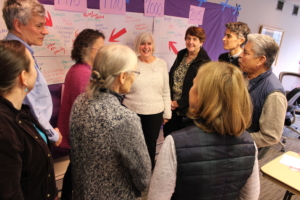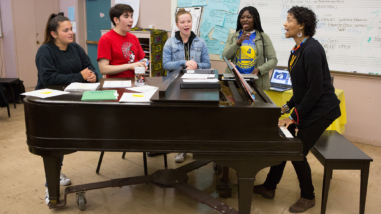 Hez Norton served as a director of TSNE MissionWorks What’s Next: Leading a Thriving Transition, a program that supports long-time nonprofit leaders to prepare their organizations and themselves for their departure and ensure ongoing sustainability. Applications for 2018’s cohorts are now open. The Hewlett Foundation has supported What’s Next in California in partnership with other funders from across the state as part of our Performing Arts Program’s focus on leadership.
Hez Norton served as a director of TSNE MissionWorks What’s Next: Leading a Thriving Transition, a program that supports long-time nonprofit leaders to prepare their organizations and themselves for their departure and ensure ongoing sustainability. Applications for 2018’s cohorts are now open. The Hewlett Foundation has supported What’s Next in California in partnership with other funders from across the state as part of our Performing Arts Program’s focus on leadership.
Why is this program needed?
We are in the midst of the largest generational transfer of leadership in the social sector, with boomers leaving their roles as nonprofit leaders. The great exodus of baby boomers (10,000 of whom turn 65 every day) that was delayed by the Great Recession and other factors has begun.
Much of the data collected from our research at TSNE MissionWorks and elsewhere tell us that up to two-thirds of leaders plan to leave their positions within the next few years. So there has never been a better time for this program to support long-time leaders to plan their transitions and leave their organizations healthy and stable for the next generation of leadership.
We know many organizations are not well-prepared for the departure of their long-time leaders. National data from CompassPoint Nonprofit Services shows that under 17% of organizations have succession plans, which is considered a best practice. Most leaders and board members are reluctant to talk about succession planning because it’s often a sensitive topic.
We believe that a key indicator of success is the amount and quality of support a departing leader receives during the transition process — both in addressing the leader’s personal journey and positioning the organization to thrive. What’s Next supports leaders to begin (or deepen) the conversation about succession planning and preparing the organization for change.
Is there a common theme among your participants, both in what they bring to the program and take away?
We found that most leaders rate their boards favorably in relation to their ability to govern the organization. But when it comes to leading a transition process, their confidence in their boards lessens considerably.
Leaders recognize the need to focus on strengthening their boards before they depart. This requires leaders to shift some of their patterns and ways of relating to the board, and begin the process of “letting go” so that the board can step up.
For many boards, this leadership transition will be the first time that they are leading without the clear direction of an executive director. This is why planning ahead and providing support is such a critical piece of the puzzle. This theme points to the importance of paying attention to supporting not just the outgoing leader but the whole organization.
What’s Next has helped leaders gain clarity on the steps they need to take to prepare for their transition, including a better understanding of their role and the board’s role. They also leave with clearer thinking about their own future as they move toward the next chapter of their lives.
What’s surprised you most about what the participants are learning?
Many leaders are worried about leaving their organization. For many, it feels like leaving a beloved child. I expected this unease. At the same time, a lot of them are very confident about the next generation of leadership.

So there is a bit of a tension here – a sense of worry and attachment about what will happen with the organization after they leave, but also an acknowledgement of their own leadership limitations and confidence in the next generation.
We also noticed that leaders are overwhelmed by the job of engaging in their succession and transition – whether they are a year or five years away from departing. Most have thought about planning, but few have engaged in any kind of action as it’s not something that is front and center in their day-to-day work.
Long-time leaders are actually managing three processes as they enter into a transition – their regular full-time job, supporting the transition planning and succession readiness of the organization, and managing their own personal transition to what is next for them in their lives. This is a lot for a leader to hold. Discussing how they can lead differently during this time has been helpful for leaders to reflect, plan and begin taking action.
How does the next generation—those who will step into new leadership roles during transition—fit into the picture?
One of the components of the program is to help leaders let go of pieces of work so others can step up, be open to exploring new ways of doing things, and ask strategic questions – all with a goal of improving the sustainability of the organization.
We are at the onset of a tectonic shift in nonprofit structures, leadership and management practices. Many in the sector question the readiness of the next generation of leaders, whether they have the needed skill, passion and dedication to lead. I believe the new leaders are ready. They will build on the successes of departing leaders, and undoubtedly bring change with different ways of thinking and working.
But even the best and brightest talent will have trouble stepping into roles in organizations that are not prepared for new leadership. The nonprofit sector has chronic sustainability issues with organizations that are underfunded, have little bench strength, challenged boards and overworked staff.
In fact, we may lose the most promising candidates who are not interested in what they see as unmanageable jobs that leave little time for learning, shared leadership and innovation. The question may be whether the sector is ready for the next generation of leaders.
One critical aspect to this Boomer transition is that it presents an opportunity to address a long-standing issue in the nonprofit sector – the lack of racially diverse leadership.
National data from CompassPoint over the past 15 years show that 75% to 80% of nonprofit leaders are white, and a BoardSource 2014 report found that 80% of board members and 90% of board chairs were white. This reality demands attention to diversity, equity and cultural competency in hiring and recruiting practices and organizational culture.
The Building Movement Project’s recent “Race to Lead” report shows that racially diverse leaders are qualified, experienced and ready to lead, but they are not getting hired. We have to do better as a sector on the issue of racial diversity in leadership and boards and cultural competency, and this generational shift opens an opportunity for long overdue changes.
What’s next for What’s Next?
We are fortunate to be able to partner with the Hewlett Foundation and three other California foundations to bring the program to the West Coast. These leadership transitions are an important moment in time for the individuals, organizations and the nonprofit sector, and we are excited to offer the program in California.

 Mike Austin
Mike Austin


